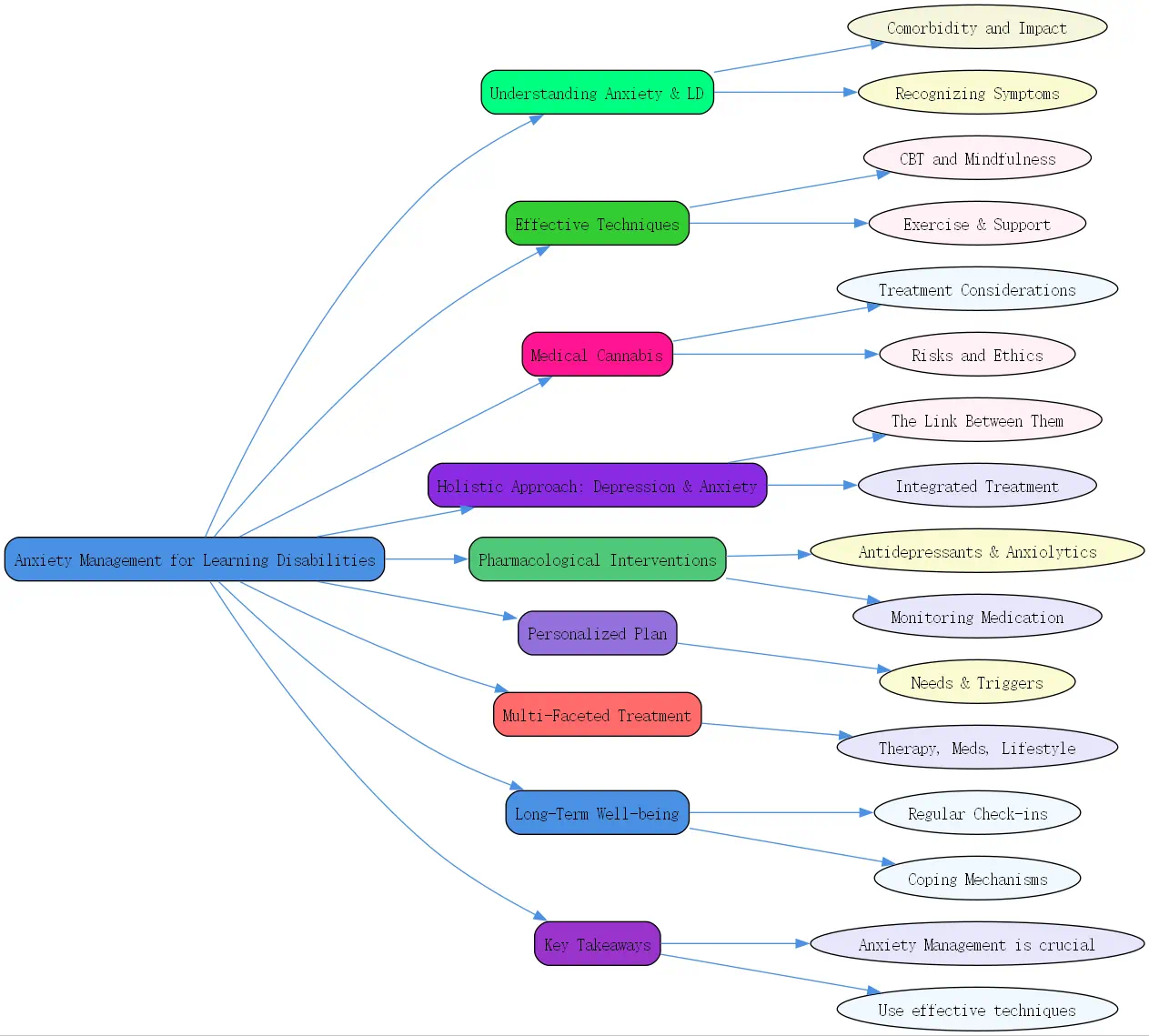Understanding Anxiety and Learning Disabilities

The Comorbidity of Anxiety and Learning Disabilities
Anxiety disorders frequently co-occur with learning disabilities, creating a complex interplay that can significantly impact an individual’s academic performance and overall well-being. Research indicates that children with learning disabilities are more susceptible to anxiety, with studies showing that up to 40% of these children may experience anxiety symptoms. This comorbidity can exacerbate challenges in learning, making it crucial to address both issues simultaneously.
Impact of Anxiety on Learning and Academic Performance
Anxiety can severely hinder a student’s ability to focus, retain information, and perform under pressure. For instance, a child with a learning disability may struggle with test anxiety, leading to poor performance despite adequate preparation. This cycle of anxiety and poor academic outcomes can lead to low self-esteem and further anxiety, creating a detrimental feedback loop. Understanding this relationship is vital for educators and parents alike, as it emphasizes the need for effective anxiety management strategies.
Recognizing Anxiety Symptoms in Individuals with Learning Disabilities
Identifying anxiety symptoms in individuals with learning disabilities can be challenging, as they may manifest differently than in neurotypical peers. Common signs include excessive worry, irritability, avoidance of certain situations, and physical symptoms such as headaches or stomachaches. Educators and caregivers should be vigilant in recognizing these signs to provide timely support and intervention.
Effective Anxiety Stress Management Techniques
Cognitive Behavioral Therapy (CBT) for Anxiety Relief
Cognitive Behavioral Therapy (CBT) is a highly effective treatment for anxiety management, particularly for individuals with learning disabilities. CBT focuses on identifying and changing negative thought patterns that contribute to anxiety. By teaching coping strategies and problem-solving skills, CBT empowers individuals to manage their anxiety more effectively. Numerous studies have demonstrated the efficacy of CBT in reducing anxiety symptoms and improving overall functioning in children and adolescents.
Mindfulness and Relaxation Techniques
Mindfulness practices, such as deep breathing exercises and meditation, can significantly reduce anxiety levels. These techniques encourage individuals to focus on the present moment, helping to alleviate worries about the future or regrets about the past. Incorporating mindfulness into daily routines can enhance emotional regulation and improve concentration, making it a valuable tool for students with learning disabilities.
The Role of Exercise and a Healthy Lifestyle
Regular physical activity is another essential component of anxiety management. Exercise releases endorphins, which can elevate mood and reduce feelings of anxiety. Additionally, maintaining a balanced diet and ensuring adequate sleep are crucial for overall mental health. Encouraging students to engage in physical activities they enjoy can foster a positive association with exercise, promoting long-term wellness.
Creating a Supportive Learning Environment

A supportive learning environment is vital for managing anxiety in students with learning disabilities. This includes fostering open communication between educators, parents, and students, as well as implementing accommodations tailored to individual needs. Strategies such as providing extra time for assignments, breaking tasks into manageable steps, and offering a quiet space for relaxation can significantly reduce anxiety levels and enhance academic performance.
Medical Cannabis for Anxiety Management: Considerations and Caveats
Exploring Medical Cannabis as a Potential Treatment
The use of medical cannabis for anxiety management has gained traction in recent years, with some studies suggesting it may alleviate symptoms for certain individuals. However, the research is still in its infancy, and the effects can vary widely among users. It is essential to approach this treatment option with caution, particularly for individuals with learning disabilities, as the impact on cognitive functioning is not yet fully understood.

Legal and Ethical Considerations of Medical Cannabis Use
Before considering medical cannabis, individuals must be aware of the legal status in their region. In many places, medical cannabis is regulated, and obtaining a prescription may require a thorough evaluation by a healthcare professional. Ethical considerations also arise, including the potential for misuse and the importance of informed consent.
Potential Risks and Side Effects
While some individuals report positive effects from medical cannabis, it is not without risks. Potential side effects include impaired cognitive function, increased anxiety in some users, and dependency issues. Consulting with a healthcare professional is crucial to weigh the benefits against the risks and to explore alternative anxiety management strategies.
Consulting with Healthcare Professionals
Before embarking on any treatment plan involving medical cannabis, it is essential to consult with healthcare professionals who can provide guidance tailored to individual needs. They can help assess the appropriateness of this treatment option and monitor its effects on overall health and well-being.
Depression and Anxiety Management: A Holistic Approach
The Link Between Depression, Anxiety, and Learning Disabilities
Depression and anxiety often coexist, particularly in individuals with learning disabilities. Understanding this link is crucial for developing effective treatment strategies. Symptoms of depression, such as low energy and lack of motivation, can further complicate the management of anxiety, making it imperative to address both conditions concurrently.
Identifying Signs of Depression Alongside Anxiety
Recognizing the signs of depression in individuals with anxiety is essential for timely intervention. Symptoms may include persistent sadness, withdrawal from activities, and changes in appetite or sleep patterns. Educators and caregivers should be trained to identify these signs and facilitate access to appropriate mental health resources.
Seeking Integrated Treatment Options
An integrated approach to treatment, combining therapy, medication, and lifestyle modifications, can yield the best outcomes for individuals experiencing both anxiety and depression. Collaborating with mental health professionals to create a personalized treatment plan can help address the unique challenges faced by individuals with learning disabilities.
Pharmacological Interventions for Anxiety and Depression
Antidepressant Medications: A Detailed Overview
Antidepressant medications can be effective in managing symptoms of anxiety and depression. Selective serotonin reuptake inhibitors (SSRIs) are commonly prescribed and have been shown to improve mood and reduce anxiety levels. However, it is crucial to monitor for potential side effects and to adjust dosages as needed.
Anxiolytic Medications: Benefits and Risks
Anxiolytic medications, such as benzodiazepines, may provide short-term relief for anxiety symptoms. However, they carry a risk of dependency and should be used cautiously, particularly in individuals with learning disabilities. Long-term use is generally not recommended, and alternative treatments should be explored.
Importance of Regular Monitoring and Dosage Adjustments
Regular follow-ups with healthcare providers are essential to ensure the effectiveness of pharmacological interventions. Monitoring for side effects, assessing symptom improvement, and making necessary dosage adjustments can enhance treatment outcomes and minimize risks.
Perinatal Anxiety and Depression
Screening During Pregnancy
Screening for anxiety and depression during pregnancy is vital for early intervention and support. Research indicates that untreated anxiety and depression can lead to adverse outcomes for both the mother and child. Implementing routine screenings can help identify at-risk individuals and facilitate timely access to mental health resources.
Self-Harm Risk
The risk of self-harm is a significant concern for pregnant individuals experiencing anxiety and depression. Understanding this risk and providing appropriate support and resources is crucial for ensuring the safety and well-being of both the mother and child.
Screening Tools
Utilizing validated screening tools, such as the Edinburgh Postnatal Depression Scale (EPDS), can aid in identifying individuals who may benefit from further evaluation and intervention. These tools provide a structured approach to assessing mental health during the perinatal period.
Creating a Personalized Anxiety Management Plan
Assessing Individual Needs and Triggers
Developing a personalized anxiety management plan begins with assessing individual needs and identifying specific triggers. Understanding what exacerbates anxiety in a learning context can inform targeted interventions and coping strategies.
Evaluating the Severity of Anxiety Symptoms

Evaluating the severity of anxiety symptoms is essential for determining the most appropriate treatment approach. This may involve self-assessment tools or consultations with mental health professionals to gain a comprehensive understanding of the individual’s experiences.
Considering Co-occurring Conditions and Individual Preferences
When creating a management plan, it is crucial to consider any co-occurring conditions, such as ADHD or depression, as well as individual preferences for treatment modalities. A holistic approach that incorporates the individual’s unique needs and circumstances can enhance the effectiveness of the plan.
Developing a Multi-Faceted Treatment Strategy
Combining Therapy, Medication, and Lifestyle Modifications
An effective anxiety management strategy should combine therapy, medication, and lifestyle modifications. This multi-faceted approach allows for a comprehensive treatment plan that addresses both the psychological and physiological aspects of anxiety.
Setting Realistic Goals and Tracking Progress
Setting realistic goals and tracking progress is vital for maintaining motivation and ensuring accountability. Regularly reviewing goals can help individuals stay focused on their treatment journey and celebrate their achievements along the way.
Building a Support Network of Family, Friends, and Professionals
Establishing a robust support network is essential for individuals managing anxiety. Encouraging open communication with family, friends, and professionals can provide emotional support and practical assistance, fostering a sense of community and belonging.
Maintaining Long-Term Well-being
Regular Check-ins with Mental Health Professionals
Ongoing support from mental health professionals is crucial for maintaining long-term well-being. Regular check-ins can help individuals stay on track with their treatment plans and address any emerging concerns.
Continued Practice of Coping Mechanisms
Encouraging the continued practice of coping mechanisms, such as mindfulness and relaxation techniques, can help individuals manage anxiety effectively over time. These skills can be invaluable in navigating life’s challenges and maintaining emotional balance.
Promoting Self-Advocacy and Empowerment
Empowering individuals to advocate for their needs is essential for fostering independence and resilience. Encouraging self-advocacy can help individuals navigate educational settings and seek the support they require to thrive.
Key Takeaways
- Anxiety management is crucial for individuals with learning disabilities, as it can significantly impact academic performance and overall well-being.
- Effective techniques include CBT, mindfulness, exercise, and creating




